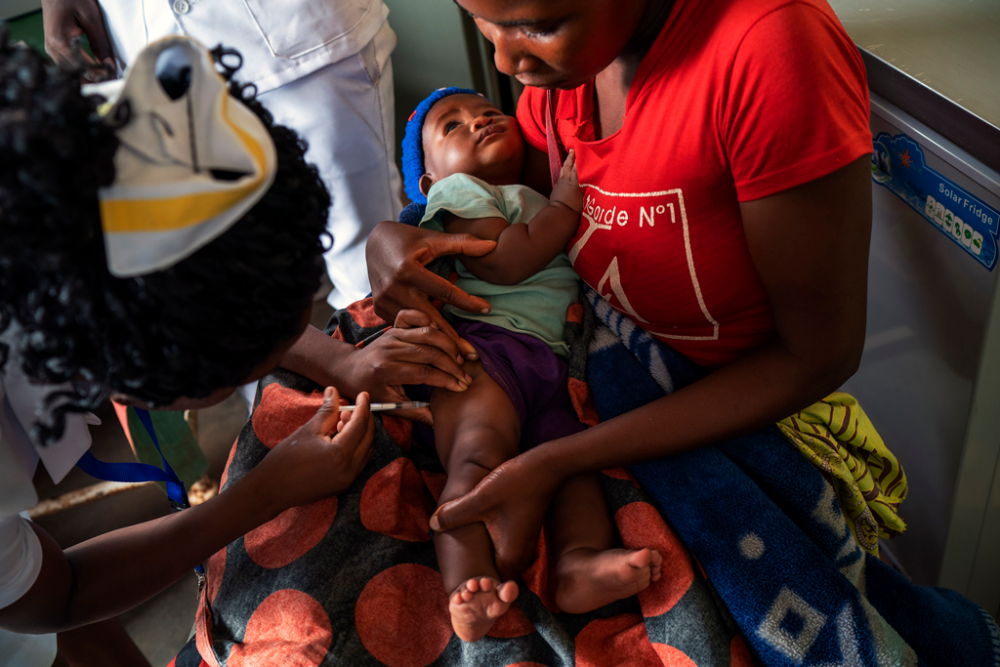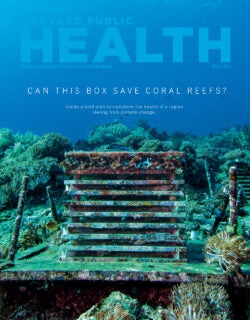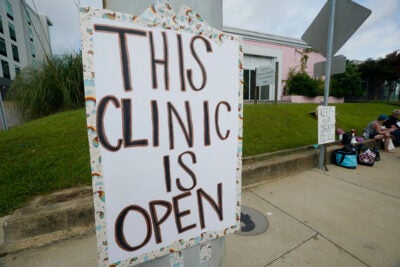News
Winter 2022: Notable news from the world of public health
Finally, a malaria vaccine

Photo: Jerome Delay / AP Photo
The World Health Organization’s recommendation of a malaria vaccine, after a long and at times faltering development effort, marks a significant milestone. The RTS,S/AS01 (Mosquirix) vaccine, which protects against Plasmodium falciparum, the deadliest malaria parasite, is the first to treat a parasitic disease. Malaria kills nearly a half million people a year, mostly children under five in Africa. Deaths spiked in 2020.
Pilot studies involving more than 800,000 children in Ghana, Kenya, and Malawi showed that RTS,S/AS01 was safe, could be administered through the routine Expanded Programme on Immunization, and was efficacious in preventing hospitalizations from severe malaria. The vaccine, which was developed by GlaxoSmithKline over a 30-year period, requires four doses starting when children are five months old.
Dyann Wirth, chair of the WHO’s Malaria Policy Advisory Group and a professor of infectious diseases at the Harvard Chan School, called the vaccine “groundbreaking” on the radio show Living on Earth. She predicted it will prompt more vaccine development. At least a dozen other potential malaria vaccines are in clinical trials.
Sign up for Harvard Public Health
Delivered to your inbox weekly.
HPV vaccines all but eliminate cervical cancer
Cervical cancer could be virtually eliminated if results from a program by Britain’s National Health Service (NHS) can be borne out globally. Between 2008 and 2012, the NHS began vaccinating girls ages 12 to 13 against the human papillomavirus (HPV) with Cervarix, which protects against the virus’s two most virulent versions. A decade later, only five women vaccinated at that age had developed cervical cancer at a rate 87 percent lower than that of women who had not been vaccinated. Women who were vaccinated as slightly older teenagers also had significantly lower rates of cervical cancer as adults. The study, reported in November in The Lancet, is the first to document the impact of vaccination on HPV rates. The health news site STAT noted that low vaccination rates within countries impede elimination of the disease.
1 Patient
seemingly cured of type 1 diabetes after Harvard biologist Doug Melton’s lab turned stem cells into islet cells and developed a potential treatment.

Photo: Annete / Alamy Stock Photo
“We have a long history of nearly eradicating something, then changing our attention, and seeing a resurgence in numbers.”
David Harvey, executive director of the National Coalition of STD Directors, on rising rates of congenital syphilis in the U.S. ProPublica, November 1, 2021
U.S. Health care’s ill repute

America’s reputation abroad is strong across many societal measures, according to a recent survey of residents of 16 democracies, including Canada as well as states in Asia, Europe, and Oceania. The big exception: health care.
Pew Research Center, Nov, 2021

Photo: InCameraStock / Alamy Stock Photo
40%
Amount of increase, on average, in exposure to cancer-causing industrial air pollution in U.S. Census tracts that are majority-minority versus those with majority-white populations.
ProPublica, November 2, 2021
Data against health racism
New York City’s Board of Health passed a resolution recognizing racism as a public health crisis in October, adding concrete anti-racism efforts to its June 2020 declaration on the issue by the city’s Board of Health. More than 120 U.S. cities have issued similar declarations, according to the American Public Health Association. New York is among the first to spell out steps officials can take to combat historical racism. The Board of Health was called on to perform actions including strengthening several aspects of demographic data gathering. New York’s resolution came on the heels of a separate $50 million program from the Robert Wood Johnson Foundation to transform public health data gathering. Today’s systems “only document racial health disparities without measuring the inequities and racism that fuel them,” Richard Besser, the foundation’s president, wrote in a post on the Centers for Disease Control and Prevention website.
“[Medical students] aren’t taught about obesity. If doctors don’t understand obesity, why would the general public? Why would policymakers?”
Fatima Cody Stanford, an obesity medicine physician-scientist at Massachusetts General Hospital and Harvard Medical School. POLITICO, October 31, 2021
Tampons are a human right, Ann Arbor says
Starting in January, all public restrooms in Ann Arbor, Michigan had to stock free menstrual products, believed to be a first in the United States. Christopher Taylor, mayor of this city of 124,000 about 36 miles west of Detroit, told NPR that “access to menstrual products is a fundamental human necessity.” While other U.S. cities have provided menstrual products in certain locations, Ann Arbor appears to be the first to require that menstrual pads, tampons, soap, paper towels, and toilet paper be available in all public bathrooms, regardless of gender. Failure to comply carries a fine of up to $100. The ordinance was passed unanimously by the Ann Arbor City Council in November, two weeks after Michigan Governor Gretchen Whitmer signed separate legislation making menstrual products tax-free in the state
In debt and in pain

Photo: Andrii Zorii / iStock
Credit card debt may be bad for your joints. So found a University of Missouri study that examined the physical health of 50-year-olds with various amounts of unsecured debt, loans not tied to collateral, such as credit card balances and medical debt (the study did not include student loans). Using data from the National Longitudinal Study of Youth, 1979 cohort, researchers found that joint pain for respondents at age 50 corresponded with ratios of unsecured debt to income.
Respondents who consistently had low levels of unsecured debt between ages 28 and 50 had the lowest incidences of joint pain. Both respondents who had paid down debt over time and those who still had high levels of unsecured debt reported more pain and stiffness compared to those with little or no debt. That suggests debt has a cumulative effect on physical health, said Adrianne Frech, an associate professor at Missouri’s School of Health Professions and the study’s lead author. Frech told Forbes that “Both debt and chronic pain can accumulate over time, so this cycle is hard to reverse once it starts.”



